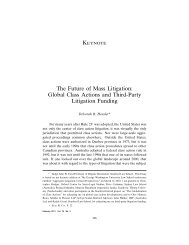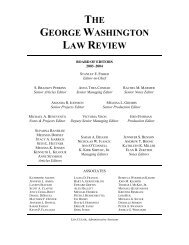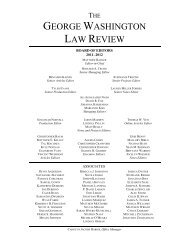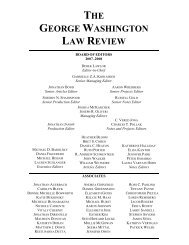View PDF - The George Washington Law Review
View PDF - The George Washington Law Review
View PDF - The George Washington Law Review
You also want an ePaper? Increase the reach of your titles
YUMPU automatically turns print PDFs into web optimized ePapers that Google loves.
2010] Oral History and the Study of the Judiciary 865<br />
been appointed in the three decades beginning with the 1960s. 81 This<br />
represents roughly one thirty-third of all the federal judges in history.<br />
82 It is not, however, a representative sample. <strong>The</strong> Seventh and<br />
Ninth Circuits dominate, while others have little or no representation.<br />
83 Even so, Domnarski assures the reader, without elaboration,<br />
that the statistical profile of his judges “varies only a bit from the statistical<br />
profile of the entire population of Article III judges.” 84<br />
<strong>The</strong> result is a very readable and enjoyable collection of insights<br />
and perspectives not only on judging and judicial institutions, but<br />
ranging as well across topics including the judges’ childhoods and law<br />
school experiences. Domnarski relates that the histories consistently<br />
take the mini-autobiography approach that characterized the Fairchild<br />
interviews, starting “with questions about the judge’s family tree<br />
before moving on to childhood, youth, college, and law school” 85 and<br />
then moving through the judge’s career up to the time of the interview.<br />
<strong>The</strong> book represents the distillation of a tremendous amount of<br />
information, and much of what Domnarski has uncovered will be<br />
quite helpful in illuminating judges’ perspectives on what they do.<br />
Still, there are limitations. This is not a systematically gathered<br />
body of data that conforms with some social-scientific ideal. Interviewers<br />
varied in terms not only of their approaches in conducting<br />
interviews, but also in terms of their training and familiarity with the<br />
judges. 86 If the histories that he read are generally consistent with the<br />
Fairchild histories that I reviewed, Domnarski had no concrete basis<br />
for assessing the particulars of the methodologies used or the preparation<br />
or skill level of the interviewers apart from whatever came across<br />
in the way they conducted their interviews. As I have suggested<br />
above, the lack of this information hinders the reader’s ability to assess<br />
the reliability of the oral histories. One of the apparent benefits<br />
of oral history is that it potentially affords the subject less opportunity<br />
to control the specifics of her message than exists in writing. It would<br />
be helpful to know whether the conditions of the interviews were such<br />
as to generate relatively more or less candor. Domnarski cannot be<br />
faulted for failing to include this information, because it most likely<br />
81 DOMNARSKI, supra note 20, at 3.<br />
82 Id. at 2.<br />
83 Id.<br />
84 Id. at 3.<br />
85 Id.<br />
86 Id. at 3–4.









